Tibet Artwork, Tibetan Buddhist Art, Buddhist Artwork, Buddha Artwork, Chinese Artwork, Tibetan Silver Jewelry , Tibetan Jewelry, Tibet Jewelry, Jewelry from Tibet, Tibetan Buddhist Jewelry, Tibetan Turquoise Jewelry, Tibetan Jewelery, Tibetan Gau Box Pendant, Tibetan Thangkas, Tibetan Malas, Tibetan Singing Bowl, Tibetan Prayer Flag
Tibet Artwork, Tibetan Buddhist Art, Buddhist Artwork, Buddha Artwork, Chinese Artwork, Tibetan Silver Jewelry , Tibetan Jewelry, Tibet Jewelry, Jewelry from Tibet, Tibetan Buddhist Jewelry, Tibetan Turquoise Jewelry, Tibetan Jewelery, Tibetan Gau Box Pendant, Tibetan Thangkas, Tibetan Malas, Tibetan Singing Bowl, Tibetan Prayer Flag
|
In the 1990s, Tibet fever raged in China and abroad. It featured the expansion of Tibetan Buddhism and an increased interest in the Tantric aspect of Tibetan Buddhism. Tibetan Handmade Jewelry and Tibetan Artworks like Tibetan Thangka, Tibetan Malas Beads, Tibetan Singing Bowl, Tibetan Satue...are widely popular among people around the world. Tibet and the Tibetan ethnic group are now the theme of numerous literary and art works, and of film and television documentaries. There are many eruditr scholars of Tibetology, and the increased publication of works of Tibetology over the past two decades has greatly improved general understanding of Tibetan culture. Tibetan People in Tibet & Nepal create a huge number of tibetan jewelry, buddhist jewelry, tibetan malas, tibetan thangkas, singing bowls, prayer box and tibetan artworks with Tibetan symbols like the buddha wisedom eyes, the six-words proverb, om mantra, klachakra symbol, the eight sacred buddhist symbols, prayer wheel, singing bowl. |
Featured Handmade Tibetan Jewelry |
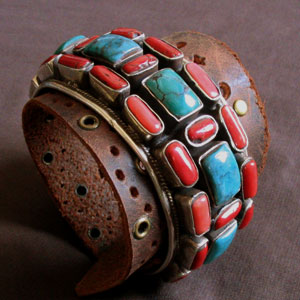
|
|
The most precious & widely used gemstones in Tibetan artworks & Tibetan jewelry - turquoise & coral. Coral is known to be used as a gem since prehistoric times. Has a history of religious meaning and is one of the seven treasures in Buddhist scriptures. Turquoise is one of the world's earliest-used gem materials. Ranked with the jades of the Orient and lapis in the Near East, turquoise has been revered for thousands of years. Coral was long thought to be a strong talisman against bleeding, evil spirits, and hurricanes. |
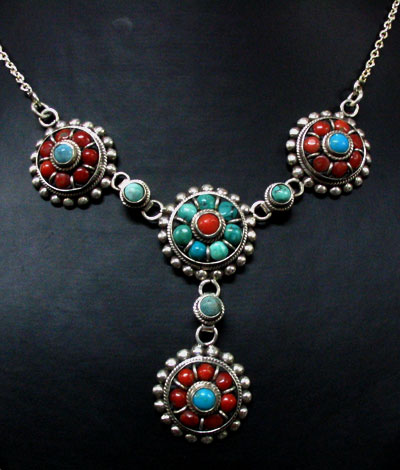
|
This Handmade Tibetan Double Stone Stirling Silver Necklace is handcrafted by the Tibetan Craftsmen from stirling silver and top-grade natural turquoise and red coral. |
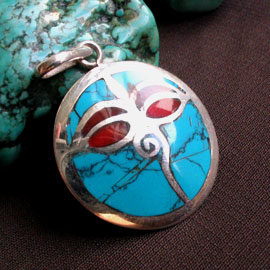
|
This Handmade Tibetan Buddha Eye Pendant was made in Nepal from stirling silver & turquoise. Buddha eye is the Nepali character for the number 1, which symbolizes unity of all the things as well as the one way to reach enlightenment—through the Buddha's teachings. Above this is a third eye, symbolizing the all-seeing wisdom of the Buddha. |
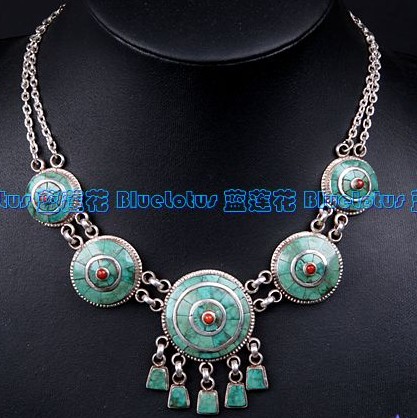
|
This Handmade Tibetan Necklace was made in Nepal from Turquoise, Red Coral, Lapis Lazuli & Stirling Silver. Very Charming Tibet Necklace. |
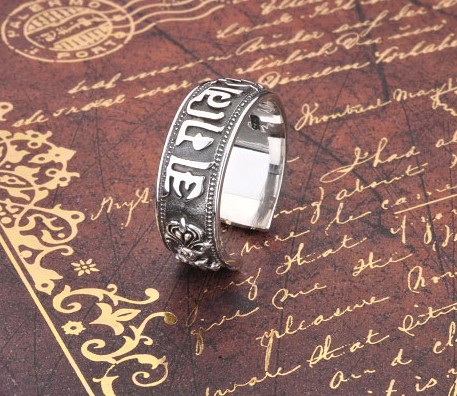
|
Om Mani Padme Hum can not really be translated into a simple phrase or even a few sentences. By pray the OM Mantra words, all of the Dharma is based on Buddha's discovery that suffering is unnecessary: Like a disease, once we really face the fact that suffering exists, we can look more deeply and discover it's cause; and when we discover that the cause is dependent on certain conditions, we can explore the possibility of removing those conditions. |
|
This pair of Tibetan Earring was handmade in Tibet from sterling silver and Turquoise |
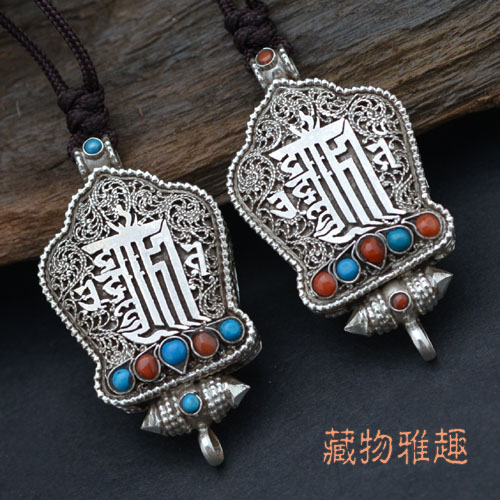
|
One of the most stunning pieces of Tibetan jewelry is the famed Ghau pendant. Also called a prayer box pendant, this jewelry piece often features rare and unusual gemstones and incredible carved silverworks. In Buddhism, the Ghau is actually a portable shrine that holds an image wrapped in silk that represents the owner's personal deity. Some Ghaus have a small opening allow you to see the personality deity. |
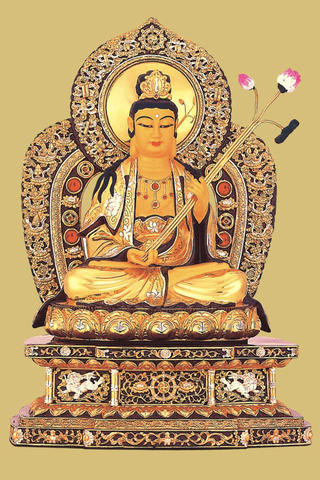
|
Tibetan Buddha Statues come in the shape of every possible Buddhist deity. In general, Buddhism is a practice of finding peace within oneself. Tibetan Buddhism is practiced by people who live in Tibetan, and there are some practices that are unique to Tibetan Buddhism. |
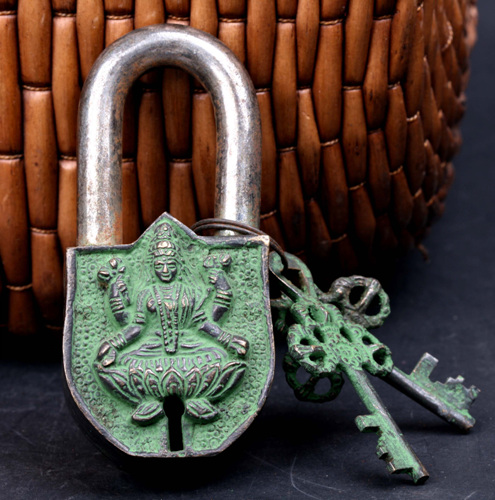
|
In Buddhist practice, singing bowls are used as a support for meditation, trance induction and prayer. For example, Chinese Buddhists use the singing bowl to accompany the wooden fish during chanting, striking it when a particular phrase in a sutra, mantra or hymn is sung. In Japan and Vietnam, singing bowls are similarly used during chanting and may also mark the passage of time or signal a change in activity. |
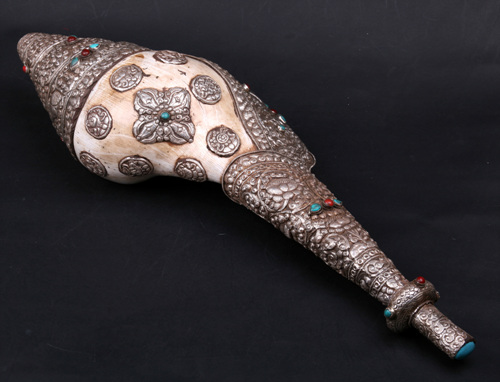
|
The conch shell is an emblem of power, authority, and sovereignty; its blast is believed to banish evil spirits, avert natural disasters, and scare away poisonous creatures. In Indian culture, different types of conch shells were associated with the different castes and with male and female. |
|
This Tibetan Buddhist Mask - Sakyamuni was made in Tibet from copper. |
|
Buddhist Beliefs
Given the association of Buddhism with the meditating monk, one might well assume that Buddhism emphasizes practices over beliefs. It is true that right practices are important in Buddhism, but the faith really centers on correct understanding of human nature and ultimate reality.
The Buddha, after all, was called the "Enlightened One." After he became enlightened, he taught that the way to eliminate suffering begins with understanding the true nature of the world. However, the Buddha considered knowledge important only insofar as it remains practical. He rejected speculation about such matters as God, the nature of the universe, and the afterlife, urging his followers to focus instead on the Four Noble Truths by which they can free themselves from suffering.
- Basic Points of Buddhism
- In the 2,500 years since the Buddha's enlightenment, Buddhism has spread over many countries, split into numerous sects, and adopted a wide variety of beliefs, practices, rituals and customs. However, an essential unity centered around the teachings of the Buddha underlies these differences.
- Is Buddhism Atheistic?
- As seen in the Basic Points of Buddhism, one general doctrine agreed upon by Buddhists is: "We do not believe that this world is created and ruled by a God." However, disbelief in a creator God does not mean that Buddhism is atheistic.
- Buddhas and Deities
- In Mahayana Buddhism, the universe is populated with celestial buddhas, bodhisattvas, and deities that assist and inspire the Buddhist practitioner. Among the most popular are Kuan Yin, the Medicine Buddha, the Laughing Buddha and the Green and White Taras. These and other fascinating figures are explored in this section.
- Human Nature
- In Hinduism, the soul, or atman, is an eternally existing spiritual substance or being and the abiding self that moves from one body to the next at rebirth. The Buddha rejected this concept.
- Purpose of Life
- In Buddhism, the purpose of life is to end suffering. The Buddha taught that humans suffer because we continually strive after things that do not give lasting happiness.
- Reincarnation and Afterlife
- The Buddha said of death:
Life is a journey.
Death is a return to earth.
The universe is like an inn.
The passing years are like dust.
Regard this phantom world
As a star at dawn, a bubble in a stream,
A flash of lightning in a summer cloud,
A flickering lamp - a phantom - and a dream.
--------------------------------------------------------------------------------------------------------
Labels: Tibet Artwork, Tibetan Buddhist Art, Buddhist Artwork, Buddha Artwork, Chinese Artwork, Tibetan Silver Jewelry , Tibetan Jewelry, Tibet Jewelry, Jewelry from Tibet, Tibetan Buddhist Jewelry, Tibetan Turquoise Jewelry, Tibetan Jewelery, Tibetan Gau Box Pendant, Tibetan Thangkas, Tibetan Malas, Tibetan Singing Bowl, Tibetan Prayer Flag
|
Skull Cups in Tibetan Ritual
Ritual skull cups are traditionally formed from a human skull that has been cut into shape, lined with a metal rim and ornamented. Many skull cups are simply made out of a precious metal in the form of a cranium. They are usually elaborately decorated with artistic designs and Buddhist symbols like lotuses and vajras. Many are fitted with ornamented lids and have feet or a separate base in the form of human skulls.
As the libation vessel of a Vajrayana Buddhist, the skull cup can be seen as a parallel of the clay pot (kumbha in Sanskrit) of the Vedic sacrifice, the alms bowl of the Buddha, and the sacred water vase (kalasha in Sanskrit) of the bodhisattvas. In addition, as a receptacle for sacrificial offerings presented to wrathful deities, the skull cup parallels the tray of auspicious substances like jewels, flowers, or fruit presented to peaceful deities. In its most benign symbolism, as the begging bowl or food vessel of an ascetic, the skull cup serves as a constant reminder of death and impermanence.
When used for esoteric rituals, the history of the cranium's original owner has an important bearing on its ritual potency. The skull of a murder or execution victim is believed to possess the greatest tantric power; the skull of one who has died from a violent or accidental death, or from a virulent illness, possesses a medium magical power; the skull of a person who died peacefully in old age has virtually no occult power. Having great potency are the skulls of children who died during the onset of puberty or were born from the forbidden union of castes, out of wedlock, from sexual misdemeanor, or particularly from incest. The vital force or potential of the skull's previous owner is embodied within the bone as a spirit, rendering it as an effective power object for the performance of rituals.
In the ritual, lamas and other advanced practitioners drink consecrated alcoholic beverages or sometimes even blood from the skull cup, symbolizing the wrathful deity drinking the blood of his or her victim
--------------------------------------------------------------------------------------------------------
Labels: Tibet Artwork, Tibetan Buddhist Art, Buddhist Artwork, Buddha Artwork, Chinese Artwork, Tibetan Silver Jewelry , Tibetan Jewelry, Tibet Jewelry, Jewelry from Tibet, Tibetan Buddhist Jewelry, Tibetan Turquoise Jewelry, Tibetan Jewelery, Tibetan Gau Box Pendant, Tibetan Thangkas, Tibetan Malas, Tibetan Singing Bowl, Tibetan Prayer Flag
Antique Tibet Skulls - Skull Cups in Tibetan Art
In Tibetan sculptures and paintings, skull cups are often seen in the hands of wrathful Buddhist deities, usually held at the level of the heart and often paired with the curved knife or chopper. The weapon slays demonic enemies, and the cup is the oblation vessel in which the blood and organs are collected as the deity's sustenance. Descriptions of the contents of a wrathful deity's kapala include warm human blood, blood and brains, blood and intestines, human flesh and fat, the heart or the heart and lungs of an enemy, the heart of Mara and the blood of Rudra.
Less often, non-wrathful Buddhist deities are depicted with a skull cup, which holds less violent contents. Padmasambhava, for example, holds a skull cup described as an ocean of nectar, in which floats a longevity vase.
tibet jewellery
buddhist ring
asian beads pendants
buddhist jewelry
tibetan turquoise pendants
asian treasures
om pendant necklaces for men
buddhist prayer box
metta bracelet
tibetan bracelets
--------------------------------------------------------------------------------------------------------
Labels: Tibet Artwork, Tibetan Buddhist Art, Buddhist Artwork, Buddha Artwork, Chinese Artwork, Tibetan Silver Jewelry , Tibetan Jewelry, Tibet Jewelry, Jewelry from Tibet, Tibetan Buddhist Jewelry, Tibetan Turquoise Jewelry, Tibetan Jewelery, Tibetan Gau Box Pendant, Tibetan Thangkas, Tibetan Malas, Tibetan Singing Bowl, Tibetan Prayer Flag
Tibet Buddha Statues
Our Tibetan Buddha Statues come in the shape of every possible Buddhist deity. In general, Buddhism is a practice of finding peace within oneself. Tibetan Buddhism is practiced by people who live in Tibetan, and there are some practices that are unique to Tibetan Buddhism. Buddhism is a religion formulated to win happiness during the present life as well as in the next. Through the influence of Karma, the mechanism that determines how a person's acts will impact their next incarnation, Buddhists practice finding the good within everything. Their desire is to live happily, not harming others and working towards their ultimate goal of enlightenment. Buddhism acts as a philosophy that regulates a person's place in the world, and the universe. Our Tibetan Buddha statue collection varies widely in terms of style and material they are made from. Some Buddha statues are made from gold, while others are made from turquoise and bronze. The statues below are of particular Buddhas who each represent certain characteristics. Please read the description below each Tibetan Buddha statue to find out the meaning of each Tibetan Buddha statue. Check out our glossary for more information on Buddhism, and start a Tibetan Buddha statue collection to add peace and tranquility in your home today.
--------------------------------------------------------------------------------------------------------
Labels: Tibet Artwork, Tibetan Buddhist Art, Buddhist Artwork, Buddha Artwork, Chinese Artwork, Tibetan Silver Jewelry , Tibetan Jewelry, Tibet Jewelry, Jewelry from Tibet, Tibetan Buddhist Jewelry, Tibetan Turquoise Jewelry, Tibetan Jewelery, Tibetan Gau Box Pendant, Tibetan Thangkas, Tibetan Malas, Tibetan Singing Bowl, Tibetan Prayer Flag
|
Buddhist Symbols
In the earliest centuries of Buddhism, statues of the Buddha were not used. Instead, Buddhist art consisted of images symbolizing the Buddha and his teachings, such as the lotus, the Wheel of the Law, the Bodhi tree and the Buddha's footprints.
Eventually, the Buddha image became one of the most popular representations in Buddhism, but these early symbols remain important and are frequently used to this day. They are especially important in Theravada Buddhist countries like Sri Lanka and Thailand.
As Buddhism spread, Buddhist symbolism was enriched by the cultures it came into contact with. This is especially true of Buddhism in Tibet, which has developed a rich symbolic tradition. The central symbols of Tibetan Buddhism are the Eight Auspicious Symbols, known in Sanskrit as Ashtamangala (ashta meaning eight and mangala meaning auspicious). The Eight Auspicious Symbols are printed on Tibetan prayer flags, incorporated into mandalas and thangkas, and used in other forms of ritual art. Another important symbol is the Wheel of Life, a symbolic representation of the universe as understood by Tibetan Buddhists.
Other important types of symbolism in Buddhism include colors, especially the five colors of white, yellow, red, blue and green, and symbolic hand gestures called mudras. The articles in this section explore these Buddhist symbols, providing information on their history, meaning and use in Buddhism today. (For an introduction and quick guide to Buddhist colors, see our Chart of Buddhist Color Symbolism.)
|

Abhaya Mudra
|

Bhumisparsha Mudra
|
|
|
|
|
|
|
|
|
|

Lotus
|
|
|
|
|
|
|
|
|
|
|
|
|
|
|
|
|
|
|
|
People and Monks
People of Tibet - The Divinest of All! Tibet serves as a home to many communities like Menpa, Han, Chinese, Sherpa, Dengs and Luopa. The area is quite thinly populated with only 1.68 persons per sq. km on an average. The overall population of Tibet is around 260,0000. The ancestors of the present Tibetans lived on both sides of Tsangpo River and mainly earned their livelihood from cultivation of barely, wheat and peas. There is also nomadic population in Tibet that keeps moving from one place to other herding their yaks and sheep. But slowly more and more people are moving towards cities for better education and job.
Are Tibetans A Holy Lot?
You will witness a number of religions practice prevailing in the region as the majority of the population is the firm follower of Buddhism. People who follow Islam and Catholicism are present in large numbers, especially in Lhasa and Yanjing. Tibet has the largest number of monks in the world with almost 1/3 of the population being a monk. They are considered to be the ultimate followers of Buddhism. Even you will feel internally rejuvenated by finding the people so optimistic and so proud of their beliefs and religion. Tibetan is the main language that is spoken here. Although the accent and pronunciation varies from region to region but most of them belong to the Sino- Tibetan phylum.
What is the Occupation of Tibetans!
Majority of the people are still confined to agriculture sector, but the number has been steadily declining. More and more people are getting educated and moving out into the cities for jobs in factories and government postings. Since most tourists more often travel only to the important destinations and leave, they miss out on a lot of local and unique stuff that is really worth visiting.
What Makes Tibitan Lifestyle!
What will strike you the most is the life style and nature of the people of Tibet. They all seem so happy and content in whatever way they live, they work, right from their homes, the dress they wear to the knife they carry, everything is so detailed and carefully chosen. Each community has its own traditional clothing for both men and women. One can easily distinguish the people from their clothing itself.
Want to Know More About The People of Tibet?
Tibet, you will learn how to be happy and live a life full of contentment without a complaint. Just pass a smile to a Tibetan who is looking at you and believe us you will get an even bigger smile in return. This is the way they are much warm, caring and full of hospitality towards their guests for whom they will go out of the way to help. To learn the simple courtesies of life and to acclimatize moral values there is no other place better than Tibet where one can learn the best of it. They seem like a new breed of humans, happy the way they are, totally unperturbed by outside world. Come to Tibet and get to know these wonderful people, from whom we can still learn a lot about life.
----------------------------------------------------------------------------------------------------------
Labels: Tibet Artwork, Tibetan Buddhist Art, Buddhist Artwork, Buddha Artwork, Chinese Artwork, Tibetan Silver Jewelry , Tibetan Jewelry, Tibet Jewelry, Jewelry from Tibet, Tibetan Buddhist Jewelry, Tibetan Turquoise Jewelry, Tibetan Jewelery, Tibetan Gau Box Pendant, Tibetan Thangkas, Tibetan Malas, Tibetan Singing Bowl, Tibetan Prayer Flag
Arts and Crafts of Tibet
Looking For Arts and Cafts of Tibet ! Tibetan art and craft is one of the virtues of the town that can be traced in its most original form, not been influenced even a bit by the western styles and traditions. And the people of Tibet are proud of their this cultural heritage. Whatever be the field, painting, music, crafts, Tibet has its own identity, its own charm.
What are the Famous Art Form of Tibet !
People of Tibet consider paintings as strong medium for spreading their knowledge and religion to all possible parts of the world. Most of the paintings portray an unshakable belief of people in Buddhism and the way they lead their life. Most of the paintings in Tibet are frescoes, cliff paintings, Thangka and wood-prints. You will see most of the cliff paintings on huge rocks and what you will find most astonishing will be the close resemblance of these paintings to mid- Asian cliff paintings. Probably, this is because the cliff painting in Tibet is prevalent from pre historic times. Even the frescoes that you will see on the walls of temples, monasteries and palaces are close to the ones that are found in India.
Is Tibet Famous For Its Handicraft Items !
Handicraft works in Tibet are quite unique and rare and their specializations are also quite incomparable. Sharp knives, as a handicraft product, are quite flattering. They are in-fact very beautiful to look at and the shape, decorations and attention given to the minutest of detail, will without a doubt leave you spellbound and definitely increases the temptation to possess one. Though you cannot carry a knife on a flight but you can definitely send them by post to your living place. So when you reach home, expect a shiny and sharp gift from Tibet, waiting for you.
Silver ornaments are also very famous in Tibet. These are worn by almost every citizen of Tibet. These ornaments are studded with different prestigious stones that also are considered to be a symbol of health and good luck. You would not like to leave Tibet without one for yourself as they are exceptionally elegant and classy in looks. Other things that should be part of your shopping list in Tibet are Tibetan carpets, masks and rugs.
Do Painted Structure Symbolize Tibet Art !
Painting of the structure in Tibet also form a major part in the showcasing the rich art skills. It is sure that the moment you enter a Tibet city, first thing that catches your eyes will be the intricate use of colors on the walls and roofs of temples, monasteries as well as houses. People here believe that colors have a language of their own and can communicate a feeling very easily. The best example of this is the Potala Palace. The red and white colors used in the building symbolizes power and peace respectively. Apart from the use of colors, even the structure of these buildings is unique.
Want to Know More About Tibet Art and Craft !
Tibet is a place where you will find art in almost all aspects of life of people. Be it the decorations in their homes, the clothes they wear or even the knife they carry with themselves should be artistic. You can find all these items to buy on the Barkhor Street which is the biggest market in Tibet. So from the time you land in Tibet, look out for some of the most stunning works of crafts and do catch the most unique form of art in the paintings, handicrafts and architecture of Tibet.
----------------------------------------------------------------------------------------------------
Labels: Tibet Artwork, Tibetan Buddhist Art, Buddhist Artwork, Buddha Artwork, Chinese Artwork, Tibetan Silver Jewelry , Tibetan Jewelry, Tibet Jewelry, Jewelry from Tibet, Tibetan Buddhist Jewelry, Tibetan Turquoise Jewelry, Tibetan Jewelery, Tibetan Gau Box Pendant, Tibetan Thangkas, Tibetan Malas, Tibetan Singing Bowl, Tibetan Prayer Flag

|
|